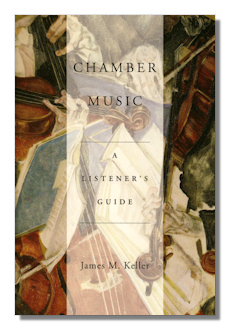
The Internet's Premier Classical Music Source
Related Links
-
Introduction
Acoustics
Ballet
Biographies
Chamber Music
Composers & Composition
Conducting
Criticism & Commentary
Discographies & CD Guides
Fiction
History
Humor
Illustrations & Photos
Instrumental
Lieder
Music Appreciation
Music Education
Music Industry
Music and the Mind
Opera
Orchestration
Reference Works
Scores
Thematic Indices
Theory & Analysis
Vocal Technique
Search Amazon
Recommended Links
Site News
 Book Review
Book Review
Chamber Music

A Listener's Guide
James Keller
Oxford University Press, USA, 2011 xix + 494
ISBN-10: 0195382536
ISBN-13: 978-0195382532
Chamber Music: A Listener's Guide is a collection of 56 short chapters examining selected small-scale compositions of 56 composers. The chapters are arranged alphabetically… Arensky to Wolf. "Chamber music" includes the Trio Sonatas of Bach, Bartók's Contrasts and Vox Balaenae by George Crumb as well as the string and piano quartets, quintets, sextets and so on. It's part of Oxford University Press's "Listener's Guides" series and so generally follows their formats. The substantive content of the book runs to almost 500 pages. There are no musical examples, although each composer's autograph is reproduced above their name at each chapter heading, which also includes a bare minimum of "tombstone" details.
If you're looking for a book that examines the structure, history, essence – even the high points – of this corner of the repertoire, this is probably not it, although clearly much informed work has gone into its writing and production. However well-written the individual commentaries on the works included are, a deeper understanding of what makes this form so appealing and how it works as it does will only come obliquely as you read extensively through the different periods and styles covered in it – by osmosis, almost, becoming repeatedly aware of themes and analyses that crop up from composer to composer; and hence define, or describe the essences of, chamber music.
These analyses cannot be faulted for the most part. What they describe they describe well, though more in program note format than lengthier, more searching dissections. For those you really need extracts from scores, musicological substance and perspectives on the genre's broader developmental than the writers here aspire to. There is useful background information in most cases and the place in the repertoire of the works is almost always well-sketched. The book would make a good gift for someone new to the area and keen to get a sense of just how many composers have embraced the medium. That's something, indeed, that may surprise more experienced listeners… the presence of Ibert and Weber as chamber musicians, for instance.
But the selection is – by the nature of things – still a selection. If the work which you're contemplating studying or of which you've just bought a recording isn't here, you'll look elsewhere. If it is, the chances are that it'll get little more than three or four pages' coverage. It could be said that what Chamber Music: A Listener's Guide lacks in depth it makes up for in breadth, for several hundred works are covered. So that does increase the scope of what you'll find.
A consequence of this is that you'll almost certainly be left with an enhanced impression of just how varied the medium of chamber music is. Works for two instruments are included, though not solo sonatas etc; as is Mendelssohn's octet. As also are pieces such as Prokoviev's "Overture on Hebrew Themes" which you might not always expect to find on the chamber music shelf. And thinking of shelves, this book might have been stronger had Keller ventured some discographical recommendations.
Not a universally useful resource, then; respective liner notes are likely to have more details. But a very wide array of material written about as well as he space allotted to each allows. For these reasons the price of almost $40 seems a little high.
Copyright © 2011 by Mark Sealey.



















